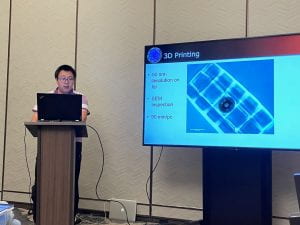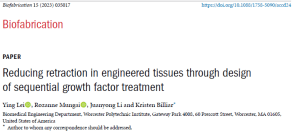In recognition of Prof. Billiar’s outstanding contributions in research, teaching and service, he was appointed by President Grace Wang and Dean John McNeill the John Milton Higgins Professor, effective January 1, 2023.
Congrats. Prof. B!
In recognition of Prof. Billiar’s outstanding contributions in research, teaching and service, he was appointed by President Grace Wang and Dean John McNeill the John Milton Higgins Professor, effective January 1, 2023.
Congrats. Prof. B!
Heartfelt congratulations Ph.D. student Rozanne on an excellent talk at SB3C! This past week, she attended the 2023 Summer Biomechanics, Bioengineering, and Biotransport Conference (SB3C 2023) in Colorado, participating in lectures, symposia, and workshops. Bravo Rozanne!

Congrats to Juanyong on an excellent talk at SB3C! He and others traveled to the 2023 Summer Biomechanics, Bioengineering, and Biotransport Conference (SB3C 2023) in Colorado this past week to participate in various events and lectures. Congratulations Juanyong!

Researcher, professor, and head of the Department of Biomedical Engineering at WPI Kristen Billiar has been given a $429,456 grant from the National Institute of Health. This endowment will support an existing project investigating the behavior of cardiovascular cells on artificial heart valves in response to mechanical stimuli. Building on his previous research involving calcium deposition causing aortic valve failure and mechanical regulation of apoptosis, Billiar hopes to better understand how mechanical forces affect cell movement and growth.
Read the full article here: https://www.wpi.edu/news/wpi-researcher-leads-project-determine-how-stretching-and-blood-flow-impact-engineered-heart-valves

Congrats to Ying on publishing her paper in Biofabridation entitled “Reducing retraction in engineered tissues through design of sequential growth factor treatment.” She and colleagues designed TGF-β1 and FGF-2 based growth factor treatments and successfully reduced tissue retraction by 85% and increased the ECM elastic modulus by 260% compared to non-growth factor treated controls without significantly increasing the contractile force. She also mathematically modeled the behavior! https://doi.org/10.1088/1758-5090/accd24

Our new paper, “Multicellular Aligned Bands Disrupt Global Collective Cell Behavior“ is here. Please let us know what you think! To read please click on the hyperlink of the paper’s name.
Our new paper “Hyaluronic Acid Regulates Heart Valve Interstitial Cell Contraction in Fibrin-based Scaffolds” is now available to download for free until December 12th.
To download please click here.
I appreciate being selected to speak about incorporating standards in my biomechanics lab in the Advances in Biomedical Engineering Education session (you can still view on Whova)
Prof. Billiar provided a “Presentation on Poster Making” for the BMES Smart Stage.
It is accessible publicly through the link: https://www.bmes.org/SSSUDrec
Alongside you can find a presentation on “abstract writing” by Dr. Reinhart King and on “presenting” by Dawn Elliot.
Biomedical Engineering Department Head and Professor Kristen Billiar was awarded the 2021 Chairman’s Exemplary Faculty Prize. The Chairman’s Exemplary Faculty Prize recognizes WPI faculty members who excel in all relevant areas of faculty performance, including teaching, research and scholarship, and advising. Recipients of the Chairman’s Prize are true exemplars of the Institute’s highest aspirations and most important qualities. Professor Kristen Billiar exemplifies these values at the highest level and distinguishes himself by his continuous and unwavering commitment to the institution, its students and broader WPI community. Notable accomplishments of Professor Billiar include leading a world-class research program in tissue mechanics and mechanobiology, being an exemplar of WPI’s innovative pedagogy, his students have won awards, published and presented their work, and received patents for work they have completed under his guidance, and leading the training of diversity advocates for faculty searches, establishing WPI’s Diversity Allies team, and serving as Inclusion Partner for the Engineering School. Professor Billiar’s demonstration of leadership and commitment to the university sets a powerful example for the rest of our community to follow. Because of him, WPI is better today than yesterday and will be better tomorrow than it is today.